Habitat
The Jack O’Lantern Mushroom is found on the ground and at the
base of dead or decaying hardwood trees. Because of its niche it
has found as a saprobic decomposer of the trees it lives on, it
is always found in forests or environments with hardwood trees.
When searching for this mushroom, there is no need to get out a
magnifying glass and dig through the forest. Its vibrant orange
color makes it easy to spot. In addition to its color, it
usually grows in a cl uster of multiple mushrooms. The image to
the right shows this growing pattern.
uster of multiple mushrooms. The image to
the right shows this growing pattern.
One thing that most people don’t know about fungi is that they can grow in the dark. Chloroplasts are what allow plants to grow, but light energy is required to carry out this process. Fungi however do not possess chloroplasts, contrary to popular belief, so they do not require light to grow. In a recent study, the effects of temperature, pH, and light were tested on the O. olearius mushroom to see what changes would affect its bioluminescent properties. It was found that temperature and pH changed the results, but light did not. The observation that bioluminescence is not affected by light change reemphasizes the idea that mushrooms don’t need light to grow. (Weitz et al. 2001) This experiment touches on another concept that helps fungi adapt to their environment. When mushrooms are growing, they do so as a mycelium. They then produce fruiting bodies to release spores and reproduce. This normal cycle can be altered by the environment, however. If a fungi senses environmental stressors, such as temperature change or flooding, the mycelium produce fruiting bodies as an attempt to reproduce as much as possible to keep their species alive throughout the stress. Mycelia are capable of producing multiple fruiting bodies in a span of just a few hours. With fungi having the ability to make mature mushrooms appear overnight, it makes the human race seem inadequate in its reproductive cycle considering that we are only capable of producing one offspring over a course of 9 months. While fungi do not use light to grow, they do use it for sporulation. Fungi produce spores in the light, and produce hypha in the dark. The mechanism of this process is not known.
The name Jack O’Lantern Mushroom refers specifically to the Omphalotus genus name. The species name is specific to the different types of Jack O’Lantern Mushrooms. Aside from a few overlapping areas, the different species are diverged based on where they are found on earth. A long standing debate has occurred in the mycological world of whether or not Omphalotus olearius and Omphalotus illudens are the same species. Omphalotus olearius is found to the east of The Rocky Mountains, while Omphalotus illudens is found to the west. Recent studies have shown that according to their DNA sequences, they are in fact two separated species. (Kirchmair et al. 2004) The most common reason for this is allopatric speciation, which is when a geographic barrier separates the two from mating with each other. The species eventually diverged and it would be uncommon for these two separate species to be able to create viable offspring if they were reunited. View the map depicted below to see where you can find an Omphalotus mushroom near you! I apologize if you live in Poland… the Omphalotus mushrooms have not been detected to live in this region.
